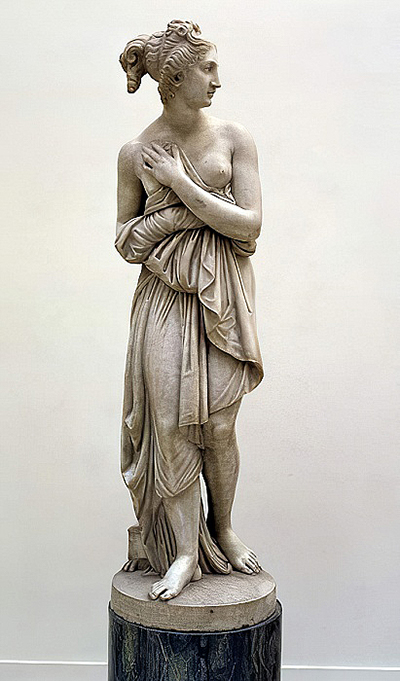Canova build his name around sculpture carving throughout Europe in the 18th and 19th Century. Born and bred in a stone cutting family, he managed to cut a niche for himself, rising to head the association of art professionals in Venice.
His statues were historical, emotive and precise, thanks to hid pupillage and training. The first lesson he got from his grandfather, a quarry owner and a stone mason, was on precision and dedication.
The Venus Italica
The statue shows a young woman standing on a pedestal. She is trying to cover her nakedness with a piece of clothes, while looking over her left shoulder. The clothes covers her front side save for one breast but her backside remains bare. At her feet lies a jewellery box. Her hair style denotes someone from a privileged background.
The first sample of Venus Italia started 1802. For the next 17 years, Canova created 2 more variants and perfected the statue. The final art commissioned in 1819 was the finest, sleekest and refined. Napoleon Bonaparte, the famous French military leader commissioned the sculpture. Made from marble, the Venus Italica is one of the best neoclassical statues in history. Currently, one of the variant can be found at the Hearst Castle’s Assembly Room.
Canova did many sculptures of the same calibre in the 19th century, among them, Cupid and Psyche (1800), The Three Graces (1817), Deadalus and Icarus (1779), Napoleon as Mars (1806), Paolina Borghese as Venus Victrix (1808). These carvings shade more on imaginative occurrences of famous people, the best presentation on influential persons and heroic stance of warriors.
Antonio Canova and His Contribution to the Neoclassical Era
Venus Italica was to mirror Venus de Medici housed at the Florence Academy of Arts. With time and dedication, Canova turned it into a masterpiece, towering over statues done at the beginning of the 19th century. In appearance and concept, the sculpture displayed Canova’s talent to the entire world. His art combines both baroque style, which he learnt from his grandfather, and classical carving witnessed towards the end of the 18th century.
He impacted his knowledge at the Accademia di Belle Arti di Venezia and Accademia di San Luca. Throughout his eventful life Antonio Canova travelled to France, England and the City of Rome. He exhibited at the Feast of Ascension and the local monastery. His work is found in Museum all around Europe.




